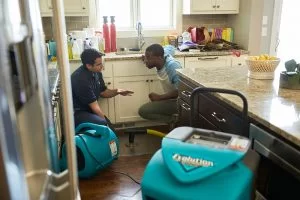Floods are major disasters that occur all over the world. Rushing waters can seep into a home without warning or may be predicted by local officials well ahead. Whether the flooding is manmade or due to natural causes, property owners should take important steps to recover from the flood damage.
What are causes of flooding?
 Heavy rains are a common cause of flooding. Prolonged, torrential downpours can overwhelm a drainage system and lead to the flooding of homes. River overflows also cause flooding. Other natural causes of flooding include melting snow and a lack of vegetation.
Heavy rains are a common cause of flooding. Prolonged, torrential downpours can overwhelm a drainage system and lead to the flooding of homes. River overflows also cause flooding. Other natural causes of flooding include melting snow and a lack of vegetation.
Manmade causes of flooding include broken dams. Aging dams, especially, can eventually fail and unleash massive waterflows into nearby homes. Leaky plumbing, faulty washing machines and dishwashers and frozen pipes that burst are also well-known sources of sudden indoor flooding.
Whatever caused the flooding, property owners are advised to respond cautiously. A flood-damaged home can be overrun with hazards. Most importantly, the home’s occupants should be accounted for. The insurance company should also be involved prior to starting the repairs.
Step 1: Administer Self-Care
The first step in recovering from a flood is to help oneself. Try to stay positive despite being surrounded by devastation. Be attentive to signs of stress. Eat nutritiously to gain energy for the many hours of flood recovery work ahead. Ask for support to healthily deal with the losses.
Step 2: Care for Others
All those affected by the flood are advised to get a tetanus shot prior to returning to the property. Since floodwaters are often contaminated with toxins, including sewage, and chemicals, like pesticides, keep small children, people with health issues and pregnant women away from the flooded area.
Drink bottled water and use it for cooking and cleaning until local authorities deem the water supply safe. Mosquitoes are rampant in wet, flooded areas, so advise everyone to wear insect repellant, avoid going outside at dawn and dusk, and remove stagnant water (breeding grounds for mosquitoes).
Pets are an important part of families and require attention in the aftermath of a flood. After a flood, contact the local humane society or American Society for the Prevention of Cruelty to Animals to begin rescue operations. Animals become stressed during disasters, so approach with caution.
Step 3: Re-Enter Cautiously
Re-enter the flood-damaged property once local officials give clearance. Remember that even after the flood, the home can be potentially filled with both hidden and obvious dangers, including slippery surfaces, uneven walkways, weakened support systems, unsafe foundations, and broken gas lines.
In fact, upon noticing structural damage, like sloping walls, a drooping roof and ceiling or weakened support columns, do not enter the home. Instead, schedule preliminary repairs. Also, air out the home prior to entering. Switch off the main electrical breaker or call the utility company to do so.
Be aware that pumping floodwater out too quickly from a flooded basement can lead to the walls caving in. Ideally, water should be pumped out gradually to avoid structural issues. Unplug the flooded appliances. When wading through the floodwater, be alert for snakes and rodents.
Step 4: Notify Insurance
 Document the losses with photographs, videos and notes for insurance purposes. Call the insurance agent to report the flood damage. Flood insurance from the National Flood Insurance Program covers the building as well as its contents. Flood insurance helps homeowners recover more quickly.
Document the losses with photographs, videos and notes for insurance purposes. Call the insurance agent to report the flood damage. Flood insurance from the National Flood Insurance Program covers the building as well as its contents. Flood insurance helps homeowners recover more quickly.
Step 5: Salvage Belongings
Homeowners can start salvaging belongings once floodwaters have receded. Many items can be saved if they are removed within 48 hours of the receding floodwater. Prior to beginning, wear rubber gloves. Throughout the salvaging process, wash hands frequently to eliminate floodwater toxins.
Wet furniture may be salvaged by taking them outside to dry. Remove the drawers and as many parts as possible to speed up the drying process. Avoid prying open drawers that have swelled and stuck tight. Rather, remove the backing and push the drawers out from behind.
Clean the mud and dirt from the wet furniture using a water hose. Wipe the furniture with a solution of half cup ammonia and half cup water to remove white spots. Rub with furniture polish. After cleaning, move the furniture to a shady spot, since sunlight will cause warping.
Step 6: Dry the Home
Mold colonies can rapidly multiply in a damp home within 48 hours of the flood. Homeowners can reduce mold growth by ensuring adequate ventilation in the home. Run dehumidifiers. Turn on fans, open windows and prop open doors if weather allows. Keep the closet and cabinet doors open.
Step 7: Clean and Disinfect
Every surface of a flooded home should undergo a thorough cleaning and disinfection. While some areas may be cleaned by the homeowner, other parts of the home require the expertise of professionals. Cleaning kits may be obtained from the American Red Cross after the flood disaster.
Step 8: Rebuild
Upon rebuilding, use strategies to floodproof the home. Choose building materials and tactics to prevent or minimize damage from future flooding. Strategies may include elevation, relocation, floodwalls, dry floodproofing and wet floodproofing. Obtain a building permit, if necessary, prior to starting.
Flood Damage Restoration – Call ServiceMaster
 Recovering from flooding is a laborious process. Reputable flood damage restoration professionals, like ServiceMaster Restoration and Cleaning, help property owners recover faster and more efficiently. We provide a full range of water damage restoration services in flooded residential homes and commercial businesses.
Recovering from flooding is a laborious process. Reputable flood damage restoration professionals, like ServiceMaster Restoration and Cleaning, help property owners recover faster and more efficiently. We provide a full range of water damage restoration services in flooded residential homes and commercial businesses.
Skilled technicians from ServiceMaster Restoration and Cleaning arrive at the flood damaged property to begin the restoration process. We extract all excess water, dehumidify the area, sanitize the property, apply an antimicrobial, provide demolition services and remove all debris. Moisture monitoring is included.
ServiceMaster Restoration and Cleaning specialists also work with insurance companies to accelerate claims. If you need temporary storage to house belongings while the property undergoes restoration, we will provide it. Our technicians also clean rugs and upholstery. We provide mold remediation to flood damaged properties.
Flood damage can be an unanticipated crisis, which is why we provide emergency flood cleanup services. Home and business owners can contact ServiceMaster Restore 24 hours a day, 365 days a year. We respond promptly to calls and are proud to serve the communities surrounding Houston, Texas.

